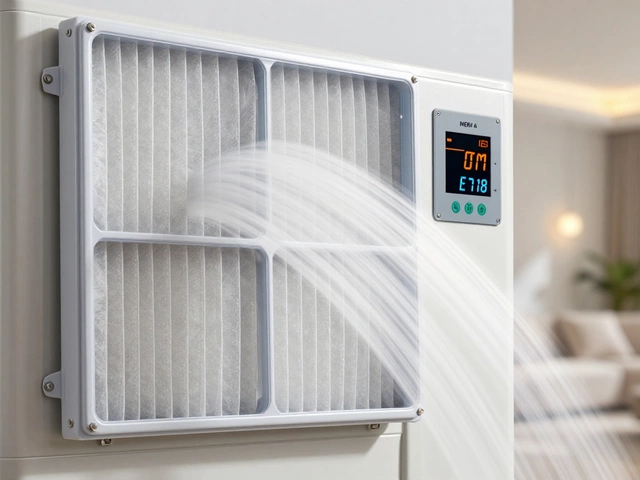
Ever been stuck in traffic on a summer's day with nothing but warm air blowing from your car's AC? Yeah, not fun. It could be your freon levels that are to blame. But what even is freon, and why does it matter? Well, in simple terms, it's the magic ingredient in your car AC system that turns hot air cold. Without enough of it, your AC might just be a fancy fan.
Figuring out if the freon is low isn't as mysterious as it sounds. Common signs include AC blowing warm air, the AC clutch failing to engage, or even ice forming on the AC lines when it's turned on. Catching these early signs can save you from uncomfortable rides and costly repairs down the line.
- Why Freon Matters
- Symptoms of Low Freon
- How to Check Freon Levels
- DIY vs Professional Refill
- Preventing Freon Leaks
- Maintenance Tips for Your Car AC
Why Freon Matters
Alright, let's talk about why freon is such a big deal for your car's AC. Imagine trying to stay cool on a scorching day without proper air conditioning. Not pleasant, right? That's where freon steps in. It's the refrigerant that makes all the magic happen, turning warm air into that refreshing cool breeze you crave.
Here's how it works: freon circulates through your car's AC system in a closed loop. It absorbs heat from the air inside your car and releases it outside. Without enough freon, your AC can't absorb this heat effectively, leaving you sweating buckets.
Now, let's be straight about something—freon isn't your everyday gas. It's specially designed for air conditioners, and there's no simple substitute. If your AC system is low on freon, it's not just about being uncomfortable. Running your AC with low freon can actually damage the compressor, which is a pricey part to replace.
Still not convinced? Here's a quick fact: The Environmental Protection Agency (EPA) states that freon leaks can harm the environment since it depletes the ozone layer. Not just harmful; it's illegal to top off a system without fixing leaks. So, keeping levels in check isn't just smart, it's responsible.
- Without enough freon, the AC clutch might not engage, meaning your system isn't operating at all.
- Running low can cause your system to freeze up, ironically, as the evaporation tends to cool the lines too much.
- Regular maintenance keeps your AC system efficient and reduces the risk of leaks, prolonging its life.
So, if you want year-round comfort and want to avoid hefty repair bills, keeping an eye on your freon levels is crucial. Plus, it's better for the planet, which is always a bonus.
Symptoms of Low Freon
Alright, so let's talk about the signs your car's AC might be suffering from low freon. You know your car best, so when something feels off, trust your gut. Here's what you should be looking out for.
First up, if your AC is blowing warm or less-than-cold air on a hot day, that's a major red flag. You've cranked it up, but it's just not doing the trick? Chances are, the freon levels have taken a dive.
Another sign is hearing unusual noises when you switch on the AC. That annoying clunk can often mean the compressor is getting too much of a workout because the freon isn't there to do its job.
And ever noticed a funky smell wafting from the vents? Yep, low freon can sometimes lead to odors, which is a clear hint something's not right inside those pipes.
Keep an eye out for the AC clutch too. When freon levels drop, the clutch might not engage, preventing the system from cooling properly.
- Warm Air Blowing: When you expect cold air, but it feels like you're in a sauna.
- Weird Noises: If your AC starts making odd sounds, give it a listen.
- Unpleasant Odors: Low levels might lead to unpleasant smells from the vents.
- AC Clutch Doesn't Engage: This is a biggie; if the clutch isn't engaging, your system won't cool as it should.
It's not always about what you feel or hear though. Sometimes, you might see it too. If there's frost or ice appearing on the AC lines, even when the weather's blazing, that could very well be a sign of low freon.
Spotting these symptoms early can dodge a lot of hassle. Don't ignore them or brush them off. Instead, consider getting it checked before you're forced to pass tissues around because of the heat!
How to Check Freon Levels
Alright, let’s get into the nitty-gritty of checking those Freon levels. First off, you don’t need to be a car expert to pull this off, but a little confidence won’t hurt. Before you start, you’ll need a few tools: a set of gauges meant for automotive air conditioning and maybe a pair of gloves. Safety first, right?
Start your engine and let it run for a few minutes with the AC turned on full blast. You’re basically giving your AC a chance to show off its cooling prowess—or lack thereof. Pop the hood and locate the AC service ports. There are two: a low-pressure side and a high-pressure side. We’re interested in the low-pressure side service port, as that’s where you’ll check the Freon levels.
- Attach the gauge to the low-pressure service port. This is usually the smaller port and should be marked. Be gentle but firm when hooking it up—you don’t want to damage the connection.
- Once connected, look at the gauge. It will show you the pressure levels. Typically, a normal low-pressure reading should be between 25 to 45 psi when the AC is running full throttle. If it’s below that range, you might be dealing with low Freon issues.
If you’re a data geek and love numbers, here’s a fun table. It sums up typical pressure readings with temperature correlations:
| Outside Temperature (°C) | Expected PSI Range |
|---|---|
| 20 | 25 - 35 psi |
| 25 | 35 - 45 psi |
| 30 | 45 - 55 psi |
Remember, if your readings are way off, consider taking your car to a professional. They have all the right equipment to handle Freon issues. DIY fixes can turn into DIY disasters if you aren't careful, and nobody wants that!

DIY vs Professional Refill
So, you've figured out that your car's AC is not cooling as it should, and you're suspecting low freon levels. The question now is, do you tackle this yourself, or leave it to the pros? Each option has its time and place, depending on your skill set and comfort level with car maintenance.
Firstly, going the DIY route can be tempting because who's not up for saving some cash, right? You can easily find DIY kits at auto stores or online. These kits usually come with a trigger dispenser, pressure gauge, and cans of refrigerant. They're designed to be user-friendly, even for those not so mechanically inclined.
- How-To Guide: Connect the dispenser to the low-pressure service port, usually located under the hood, and follow the instructions on the can. Ensure your car engine and AC are running when refilling.
- Important Tips: Always wear protective gear and avoid overcharging, as it can damage your car radiator system.
Despite its appeal, DIY isn't always the best choice. Handling refrigerant comes with risks, both in terms of safety and legal regulations in some countries. Incorrectly refilling can lead to further issues.
- Environmental Concerns: Mishandling refrigerants can release harmful chemicals into the atmosphere, which is a big no-no.
- System Damage: Adding too much refrigerant can blow seals or even damage the compressor.
On the flip side, opting for a professional refill means you're getting expertise, peace of mind, and oftentimes a check-up of your entire AC system. They’ll check for leaks, which is crucial since most freon escapes through tiny leaks. They’ll also ensure everything's running smoothly.
So, which should you pick? If you’re confident in your skills and just need a top-up, DIY might be the way to go. But, if you're unsure or suspect leaks, professional help can save you from more headache and cost in the long run. Plus, shops usually have top-notch tools and experience to keep your AC maintenance on point.
Preventing Freon Leaks
Freon leaks can sneak up on you and wreck your car's cooling system. So, how do you keep them at bay? Well, it all starts with regular maintenance and a keen eye for detail. This doesn't mean you have to obsess over your car's AC every day, but a little attention now and then can go a long way.
The first step in preventing leaks is to keep an eye on your car radiator and AC components for any wear and tear. Look out for cracks, corrosion, or any strange sounds from the AC unit. These are often the first signs something's amiss. Make it a habit to check your AC system every few months, especially before the hot summer months kick in.
A great way to catch potential problems early is using UV dye. Add the dye to your AC system, and if there's a freon leak, it'll show up under a UV light. It's like detective work but way cooler because it's all about keeping your ride comfortable.
Don't forget, a little investment in professional inspections can save you heaps in the long run. A service technician can spot tiny issues that might not be visible right away. They can also recharge your AC and make sure the freon level is optimal for those scorching days.
Want a quick glance at where leaks often occur? Check out this handy table:
| Area | Common Issues |
|---|---|
| AC Hoses | Cracks, loose fittings |
| AC Compressor | Worn seals, damage |
| AC Condenser | Corrosion, physical damage |
Remember, a bit of prevention goes a long way in maintaining your car's AC system. Keep the freon where it belongs, and you’ll enjoy a cool, comfy drive every time.
Maintenance Tips for Your Car AC
Keeping your car's AC in top shape isn't just about comfort; it's about being smart with your ride's longevity. If you’ve noticed signs like warmth instead of a chill, it could be a clear symptom of low freon. Let's dive into some practical tips to maintain the efficiency of your car's air conditioning system.
First off, regular checks are your friend. Make it a habit to check your AC system at the start of each summer. Pop the hood and have a look at the AC parts, especially the compressors and the ducts. Any visible cracks or leaks? These could mean your freon is slowly escaping.
Next up, consider using a UV dye leak detector. This handy little tool is used to find those sneaky leaks that might not be obvious. Just add a bit of dye to the AC system and use a UV light to spot any trouble.
Thirdly, use your AC regularly. Yeah, it sounds odd, but running your AC for about 10 minutes once a week, even in winter, keeps the system well-lubricated and avoids any seals from drying out.
- Regularly replace the cabin filter. It sounds simple, but a clogged filter can make your AC work harder and less efficiently.
- Keep an eye on your car's temperature gauge. If your car tends to overheat, it might put extra stress on the AC system as it works double time to try and cool down the cabin.
- Pay attention to strange noises. Odd sounds when you switch on the AC could be whispering warnings of a compressor issue. Don’t brush them off!
And if you're unsure? Don't hesitate to take your car to a professional. A quick consultation could potentially save you loads of cash in the long run.
Sometimes it’s worth comparing fuel efficiency statistics before and after any maintenance to see if your adjustments have made a difference. Here's a simple way to track it:
| Before Maintenance | After Maintenance |
|---|---|
| 25 miles per gallon | 28 miles per gallon |
Maintaining your car’s AC is like insurance for a comfortable drive, ensuring everything works as it should when you need that blast of cold air the most. And hey, who doesn't love a car that feels like a fridge when it's blazing hot outside?





